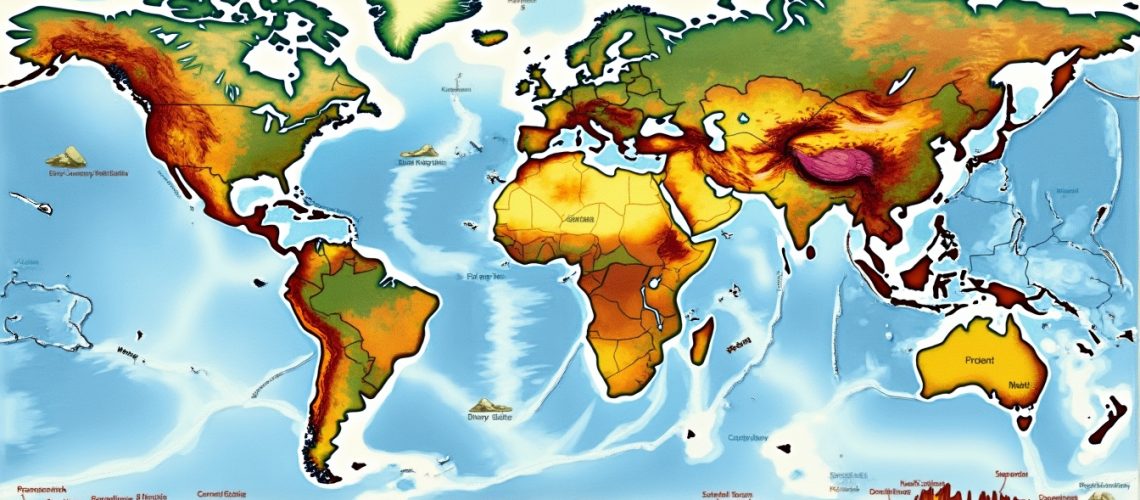The Geological Link Between North China and Australia: A 450-Million-Year Tectonic Journey
The story of Earth's ancient continents is one of continuous and remarkable tectonic evolution. For millennia, the processes of tectonic evolution have dictated the rise and fall of landmasses, carved mountain ranges, and created vast mineral deposits. Understanding this 450-million-year connection between North China and North Australia not only illuminates the past but also offers valuable insights into modern geological processes.
Unraveling the Ancient Connection
Earth’s early tectonic evolution set the stage for the formation of supercontinents like Nuna. Dating back between 1.8 and 1.2 billion years ago, Nuna brought together diverse cratonic fragments that now span continents. One of the most fascinating links within Nuna is between the North China Craton and the North Australian Craton.
These two ancient land masses shared a deep-rooted geological kinship that influenced every aspect of their development, from sedimentary patterns to the formation of mineral deposits. For instance, studies have shown that the principles of plate tectonic influence played a vital role in shaping the geochemical signatures we observe today.
How Did Tectonic Evolution Shape These Regions?
The concept of tectonic evolution is well illustrated by the paleomagnetic records from both cratons. Scientists have uncovered that around 1.78 billion years ago, both land masses possessed nearly identical magnetic poles—a clear indicator that they resided in the same geographic domain. This synchronised history is essential for understanding the subsequent geological developments:
- Evidence of uniform magmatic events at around 1.73 billion years underscored the tectonic unity of the regions.
- Sedimentary records reveal striking similarities in ecosystem development and clastic sedimentation.
- Shared hydrocarbon processes signal a common mantle source from which both cratons drew their geological energy.
Moreover, the continual tectonic evolution ensured that both cratons maintained a relative stability during their prolonged association. Later, around 1.32 billion years ago, a pronounced mantle plume triggered dramatic changes, leading to magmatic events that eventually separated the land masses.
Beyond the Earth’s Crust: Sedimentary, Fossil, and Geochemical Stories
Sedimentary and fossil records offer compelling proof of the intertwined past of these continents. In locations such as the Yanlaau Rift in North China and the Maiwafa Basin in North Australia, geologists have identified shared sedimentary cycles and fossil distributions. These include:
- Extensive clastic sedimentation across both regions.
- Occasional carbonate deposits, such as dolostone layers, dated at around 1.64 billion years.
- Similar environments that hosted early eukaryotic microfossils.
Geochemical analyses further strengthen the link between the two cratons. Synchronous mafic magmatic events yielded nearly identical mineralogical compositions, including:
- Mean dolerite dykes with parallel chemical traits.
- Flood basaltic events during a massive Large Igneous Province episode around 1.32 billion years.
- Comparable isotopic signatures that reveal a unified mantle source.
The continuous interplay of tectonic evolution and these geochemical processes not only shaped the ancient landscapes but also set the stage for the eventual breakup of Nuna.
Mineral Deposits: The Economic Legacy of a Unified Past
One of the most striking legacies of this deep geological connection is seen in mineral deposits. The similar depositional environments experienced by North China and North Australia have left behind a wealth of economic resources. Detailed studies of these deposits have revealed that:
- Dolostone-hosted manganese deposits occur with nearly identical compositions across both regions.
- Iron formations display comparable distributions of hematite and siderite minerals.
- Organic-rich mudstones suggest parallel hydrocarbon generation scenarios.
These mineral deposits stand as a testament to how tectonic evolution can drive not only geological but also economic outcomes. In nearby regions, the exploration of significant mineral riches is ongoing. For example, the work detailing the significance of the porphyry deposits dynamics has reshaped the way geologists perceive mineral formation. Simultaneously, the discovery of resource-rich zones near the northparkes copper-gold mine further illustrates the global importance of these ancient geological processes.
The Final Breakup: Mantle Plume and Tectonic Divergence
The profound events of tectonic evolution are also vividly exemplified by the final breakup of Nuna’s core. Around 1.32 billion years ago, a significant mantle plume event induced extensive magmatism that not only transformed the crust but also drove considerable uplift and restructuring. Key components of this breakup include:
- Widespread dyke emplacement, which marked the initial fracturing of the continents.
- Uplift mechanisms that led to crustal weakening.
- A shift in the relative positions of the cratons, eventually setting them on divergent paths.
This pivotal moment in tectonic evolution has not only redefined the physical landscape but also provided modern researchers with valuable data for understanding the long-term stability and transformation of Earth’s crust.
Economic and Environmental Implications Today
The geological processes detailed above have far-reaching implications beyond academic interest. In Australia, for instance, modern mining operations reflect the legacy of this ancient history. The robust link between tectonic evolution and mineral deposit formation has spurred further exploration into sustainable resource extraction. The dual role of mining, balancing resource extraction with environmental concerns, is clearly illustrated by discussions on mining's role in energy transition. This role is increasingly relevant in a world focused on clean energy initiatives and sustainable practices.
To summarise, key economic points linked to tectonic evolution include:
- The identification of mineral wealth driven by similar depositional events.
- Advanced research into the economic benefits of regional resource growth, backed by initiatives such as the regional resource growth grants in the Northern Territory.
- Increased investment in mining research, which is now evolving to support clean energy goals.
Modern external resources such as the geological community at bgs offer continued insights into how ancient tectonic evolution influences today’s mining and exploration efforts. Equally, global media platforms like national geographic serve as valuable companions for those interested in the interplay between Earth’s dynamic processes and modern-day geology.
How Does Tectonic Evolution Inform Our Future?
The rich tapestry of tectonic evolution, as traced from the days of Nuna to our modern landscape, remains a cornerstone of geological research. The intricate dance of continental drift, magmatic events, and mineral formation gives us tools not only to understand our past but also to plan for the future. Researchers are now using these ancient signals to guide modern exploration and sustainable resource development strategies.
In this ongoing journey, tectonic evolution continues to serve as both a historical record and a predictive tool. By understanding the interplay between plate movements and mineral deposit formation, we are better equipped to forecast where untapped resources lie. This insight fosters a collaborative relationship between geological research and modern economic planning, ensuring that the legacy of our ancient past contributes sustainably to our future.
Over the course of this exploration, the primary keyword—tectonic evolution—has been a recurrent theme that threads through every segment of this discussion. It stands as the backbone of not only historical geological processes but also modern discoveries and economic strategies. Whether through the lens of paleomagnetic evidence, sedimentary records, or economic outcomes, tectonic evolution remains central to both the study and application of Earth sciences.
The intertwined narratives of North China's and North Australia's geological past remind us that the Earth's crust is a living record of ever-changing forces. By delving into these ancient ties, we not only pay homage to our planet's dynamic history but also unlock promising avenues for future research and innovation.
Are You Ready to Invest in Geological Marvels?
Explore how Discovery Alert’s AI-driven notifications and geological analysis can help you seize opportunities on significant ASX mineral discoveries, such as those shaped by ancient tectonic journeys. Dive into our services with a 30-day free trial to elevate your investing strategy now by visiting Discovery Alert.







